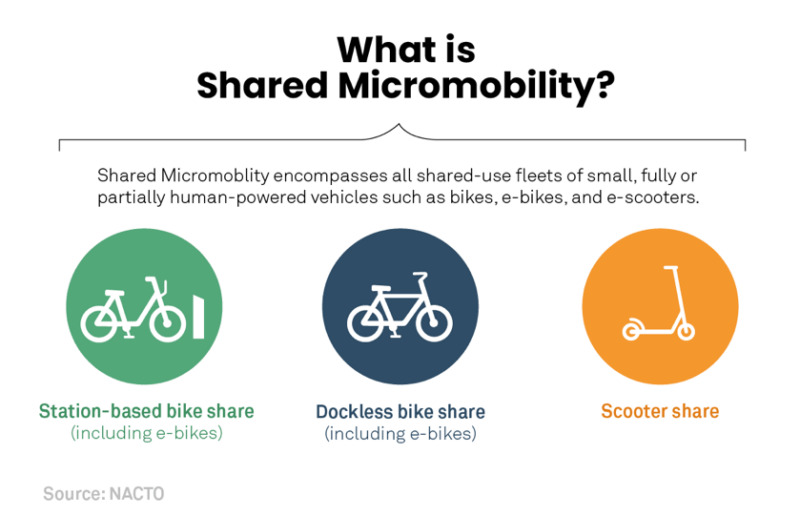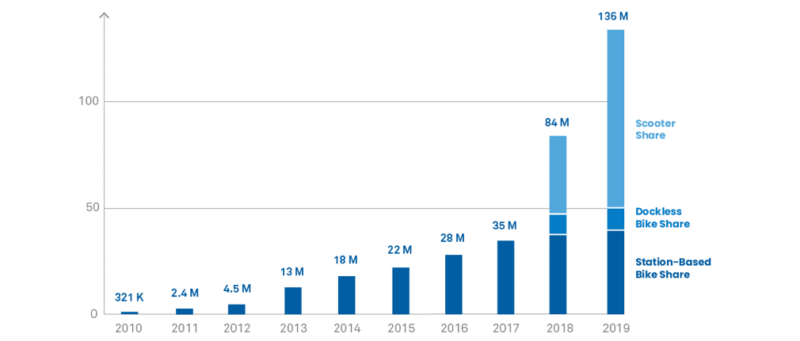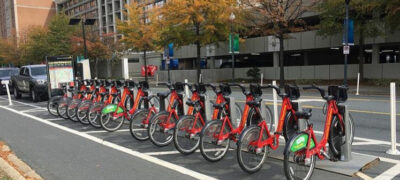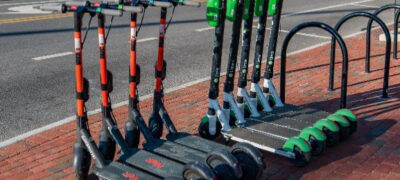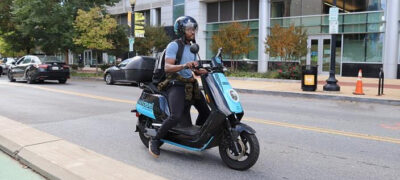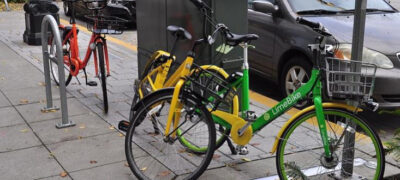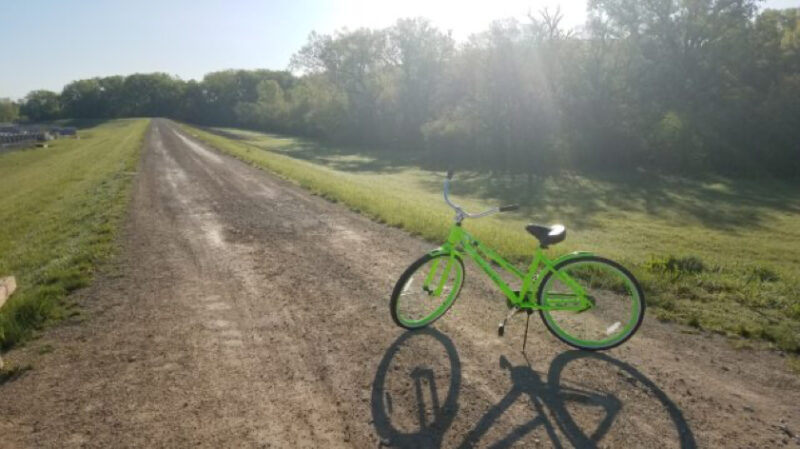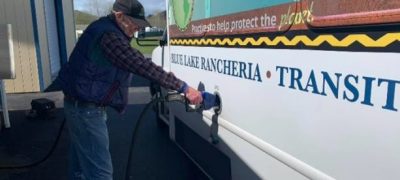2.1 What is Micromobility?
“Micromobility” is a relatively novel term used to describe a familiar concept: small, low-speed vehicles intended for personal use, such as bikes, scooters, mopeds, and microcars. Many (but not all) micromobility services are electrified, offering users either an electric boost or being entirely electrically propelled. “Shared micromobility” is a more specific phrase that describes micromobility devices to which a user can gain short-term access, often through a smartphone application. For the purposes of this guidebook, the term “micromobility” will refer to the concept of shared micromobility. Micromobility is a form of shared transportation for communities. These systems provide the public a way to efficiently and cost effectively get around.
While the term micromobility has only been in use for a few years, the concept of micromobility has been around for decades. The earliest bikeshare system was established in 1960’s with free-to-use bicycles scattered across city centers, but early systems struggled to gain traction due to the inability to prevent vandalism and theft. It was not until the mid-2000s that a host of technologies, such as cellular connected locking mechanisms and account-based rentals enabled a new generation of bikeshare systems that successfully secured bicycles. Modern micromobility programs gained traction in the U.S. in the 2010 with the launch of large-scale station-based docked bikeshare systems (Nice Ride MN, in Minneapolis, MN and Capital Bikeshare in Washington, DC). Since that time the market has grown to include multiple other system types, including free-floating dockless bikeshare, electric scooters, and more recently electric mopeds, where users are typically accessing vehicles and devices through app-based accounts.
Micromobility is one of the fastest growing segments of transportation in the US. Between 2014 and 2019 combined, micromobility trips in the US increased by 618 percent to 136 million trips in 2019 (see below) (NACTO 2020). According to the consulting firm McKinsey, the American micromobility market is projected to grow in valuation to over $200 billion by 2030 (Heineke, Kloss and Scurtu 2020). As just under 60 percent of household vehicular trips nationwide are under six miles (Department of Energy 2018), micromobility could serve a large share of daily trips across the country.
2.2 Micromobility Modes
Micromobility can describe an ever-growing number of modes that share common characteristics like being low speed, available for point-to-point trips for short-term rentals, and designed to carry one or two riders. While many of these modes can compete with one another, these modes complement each other as well. Scooters and bikeshare excel at serving short point-to-point trips where the rider has limited baggage. Electric assist bicycles provide the ease of use and rider comfort to support longer distance and duration trips than traditional bikeshare. Finally, modes like microcars and mopeds are sometimes also considered micromobility and allow users to carry cargo and travel over distances of several miles with ease. While micromobility services have flourished over the last decade in large cities, the growing diversity in technologies mean that now more than ever, these services can be tailored to the unique needs of small urban, rural, or tribal communities.
2.2.1 Bikeshare
The earliest form of modern micromobility, bikeshare, takes a variety of different forms. Bikes can be conventional or electrified, usually with either pedal-assist (when the rider pedals, an electric motor gives them a boost) or a throttle (the rider does not have to pedal; electric propulsion is controlled via a throttle on the handlebars). The bikes have speeds of around 10-20 mph, depending on propulsion (and the rider, for conventional bikes). The bikes are rented from and returned to a dock or are free-floating and unlocked or locked from anywhere within a geofenced zone. Figure 3 shows an example of a docked bikeshare station. Section 2.4 explains the differences between docked and dockless systems. Bikeshare systems are often smartphone application-based, but some systems allow bikes to be accessed through a payment kiosk, card, or tag.
What differentiates bikeshare from traditional bicycle rentals is how the service is intended to be used: bicycles are available for one-way trips, with users to encouraged to take short trips instead of holding onto the bicycle for an entire day or week.
2.2.2 Scootershare
Shared electric scooters first came on to the micromobility scene in the U.S. in 2017, when the company Bird launched operations in Santa Monica, California. By 2019, scooters surpassed bikeshare as the most ridden shared micromobility mode. In 2019, 109 cities had scootershare programs and ridership had increased year-over year by 135 percent to over 85 million trips (NACTO 2020). Shared electric scooters are small and lightweight, typically with a platform for standing or a seat, as shown in Figure 4. Propulsion is controlled via a throttle and brakes on the handlebars, and they have speeds typically limited to between 10-20 mph (though some communities may restrict them to lower speeds in select areas).
Unlike bikeshare, scootershare systems are nearly identical in operations. They are almost exclusively dockless and rented through a smartphone application. Some jurisdictions (such as Washington, DC) require riders to lock their micromobility vehicles to bike racks or other designated locations to reduce clutter and sidewalk blockage.
2.2.3 Emerging Technologies
While bikeshare and scootershare are the two most common forms of micromobility available in the U.S. today, two other forms are being introduced in this country and around the world. One, electric mopeds, are already commercially available in New York City, Washington, D.C., San Francisco, Miami, Pittsburgh, and Austin, from three companies: Revel, Lime, and Scoobi. These are larger, two-wheeled mopeds (similar to a Vespa or other motor scooters) that are electric-powered and capable of speeds up to 30 mph. Similar to scootershare, they are dockless, rented via a smartphone application, and charge a flat unlock fee plus a per-minute rate, though some systems have hourly and daily passes available. Figure 5 shows a person riding a Revel electric moped in Washington, D.C.
2.3 Dockless vs. Docked
Micromobility services are commonly broken into two broad categories: Docked and dockless systems. Docked micromobility describes any system where vehicles must be returned to physical “stations” where the vehicle (typically a bike) is locked to a physical dock, shown previously in Figure 3. In most docked systems, much of the mechanical and electronic elements of the system are part of the station and trips must start or end at a functioning station. Dockless systems move the computer and locking hardware onto the vehicle themselves, enabling trips to start or end anywhere. There are benefits and drawbacks of both types of technology (see Table 2: Common Strengths and Weaknesses of Docked and Dockless systems, below).
| Type | Strengths | Weaknesses |
| Docked |
|
|
| Dockless |
|
|
2.4 Grassroots / Community-Based Programs
The models of bikeshare and scootershare systems described in the previous sections are predominantly in operation in medium and large cities in the U.S. Smaller communities face many hurdles to implementing micromobility: they may not have the funds required to start a program; demand may be insufficient to attract a private operator; or they may have a large portion of their population that does not have a smartphone or is unbanked and therefore cannot access systems that require a smartphone and/or credit card. More information is available in U.S. DOT’s Shared Micromobility and Equity Primer. Many communities have a solution that is significantly older than internet-based micromobility: bike libraries.
Bike libraries are a system by which users can rent or borrow bikes on an hourly, daily, or even weekly basis, either for free or for a small fee. In most cases, the user only has to present an ID, library card, or other similar document to “check out” a bike and sign a waiver for safety and liability concerns. Rentals usually include a lock and helmet. Bike libraries are often operated publicly or by local non-profit organizations and funded through local government and community grants; equipment can be donated or upcycled from other bikeshare providers. Often, maintenance is performed by a local bike shop. For example, at the Anythink public library in Commerce City, Colorado, any person with a library card can rent a bike, lock, and helmet for up three weeks for free. Thrive Allen County, a rural health advocacy organization, operates a free bikeshare system in Allen County, Kansas, where anyone can rent a bike with only a photo ID. These systems address many concerns with bikeshare, as they are accessible to nearly everyone regardless of smartphone or credit card access and have comparatively low startup and operations costs.
2.5 Micromobility Usage
In 2020, 203 cities in the U.S. had some form of micromobility available. One-hundred-and-sixty-seven cities had bikeshare systems while 129 had scootershare for a total of 142,000 vehicles available to the public. Of the cities with bikeshare systems, 56 percent of those systems were docked, 19 percent dockless, and 25 percent were both, while 44 percent of systems had e-bikes available. Almost all scootershare systems are dockless (NABSA 2021). In 2019, micromobility ridership in the U.S. was over 136 million trips, a 60 percent increase from 2018 (NACTO 2020).
The COVID-19 pandemic had a significant impact on micromobility usage: 2020 micromobility trips declined 70 percent in April compared to the previous year, a significantly larger decline than total trips overall. However, likely because it is easier to social distance on micromobility than other shared modes (and because it allows outdoor recreation), micromobility usage had rebounded to within 20 percent of 2019 levels by November 2020, better than total trips overall and significantly better than the recovery in ridership on traditional public transit. Figure 9 shows the percent change in micromobility, transit, and total trips by month in 2020 compared to 2019. Reflecting trends in trip patterns across all modes, micromobility usage had changed: 60 percent of providers reported a reduction in weekday trips, while 50 percent noted an increase in weekend trips, and 60 percent reported that time of day for trips had changed substantially (NABSA 2021).
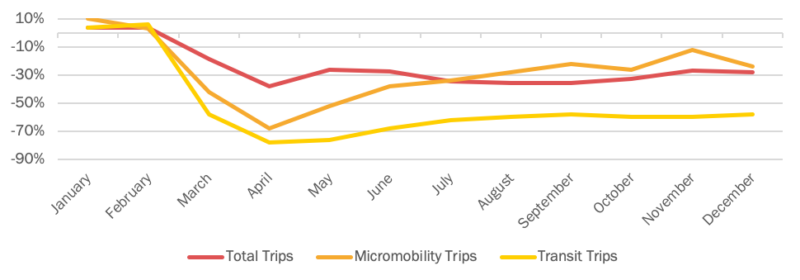
The demographics of micromobility users are more likely to be higher-income, younger, white, and male compared to the areas that they serve. Despite this, the proportion of low-income, female, and racial minority ridership increased in 2020 compared to 2019; many micromobility programs operate equity programs to attract underrepresented groups of riders to their systems (see Section 4.6 Equity) (NABSA 2021).
Micromobility usage has the potential to replace personal vehicle trips over short distances. The average micromobility trip duration in 2019 was 11 minutes and the average trip distance was 1.5 miles (NACTO 2020). In one survey of six cities, NACTO found that 45 percent of micromobility trips replaced a personal vehicle or ride share trip, while 37 percent replaced a walking or transit trip, and 18 percent of trips replaced other modes or wouldn’t have been taken at all (Figure 10). Additionally, 16 percent of micromobility trips were used to connect with transit (NACTO 2020).

Despite the decline in usage due to the COVID-19 pandemic, micromobility rebounded quickly and its usage can be expected to grow in the coming years as the technology becomes more widely adopted. Increasing investment in pedestrian and bicycle infrastructure will help increase usage by making riders feel more comfortable and safer. Further investment in equity programs that address barriers to micromobility usage, such as lack of smartphone access, credit card access, lack of physical access, disability accessibility issues, and familiarity with the concept will help reduce disparities in usage and benefits in the future.
2.6 Micromobility Pricing
As mentioned earlier, micromobility is geared toward serving short point-to-point trips and the pricing of services is often designed to incentivize such usage. Many programs focus on encouraging frequent turn-over so that one user is not in possession of a vehicle for most of the day. The two most frequent fee structures are:
- Time-based pricing, where the user pays based on how long they ride. While a per-minute fee is the most common, some systems charge by other time increments, such as per-30-minutes. Sometimes time-based pricing is combined with an unlock fee of $1 or $2.
- Subscriber based pricing, where users purchase a pass that is valid for a certain length of time, such as one day, week, month, or year. The pass allows unlimited trips below a certain duration. Trips above a duration (typically 30 to 60 minutes) incur additional usage fees to dissuade the rider from keeping the vehicle when it is not in active use.
In rural settings, providers may have less reason to encourage rapid turn-over of micromobility vehicles. Travel distances in rural areas tend to be long, and demand may be insufficient to necessitate short time limits on usage.
